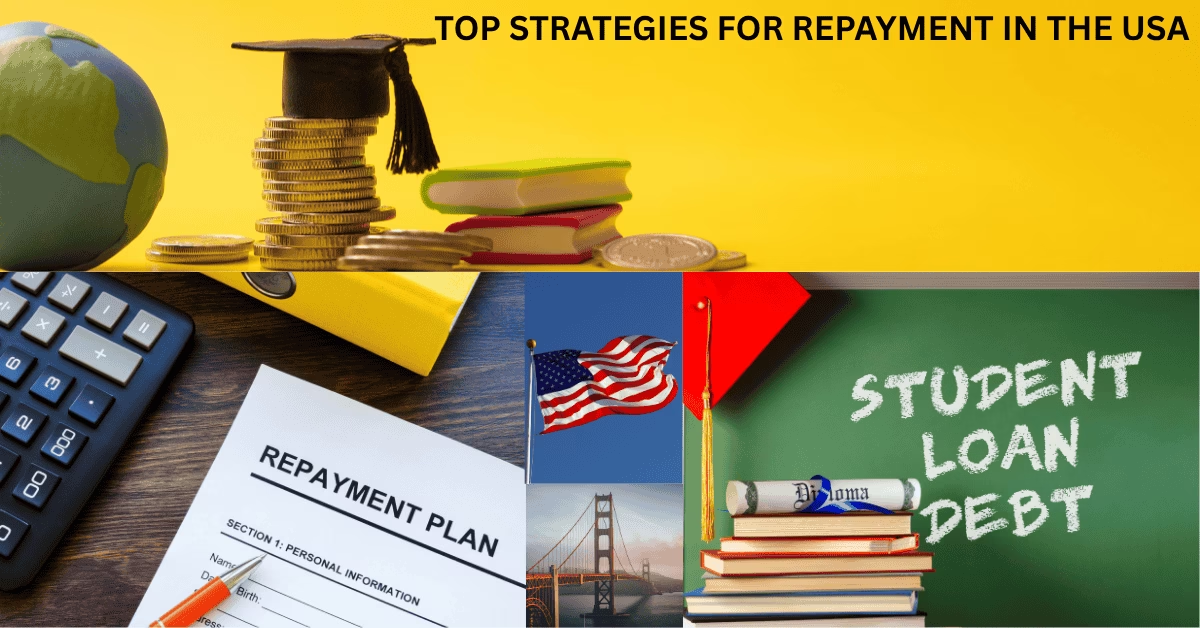Student loan debt is a reality for millions of Americans, with the average borrower owing around $30,000, and some graduate school borrowers facing six-figure balances. But with the right strategies, you can manage and pay off your loans efficiently, even on a tight budget. This comprehensive guide covers everything you need to know about navigating student loan debt in the USA, including repayment plans, who to contact, creative payoff strategies, and more—all in clear, easy-to-understand language. Let’s dive into the best ways to tackle your student loans in 2025.
Understanding Your Student Loans

Before diving into repayment strategies, take stock of your loans. Are they federal or private? What’s the interest rate, balance, and repayment term? Log into studentaid.gov for federal loans to view details like loan type (subsidized, unsubsidized, or PLUS) and your current repayment plan. For private loans, contact your loan servicer or check your credit report at annualcreditreport.com. Knowing these details helps you choose the best repayment strategy.
Who to Contact for Questions About Repayment Plans
If you have questions about repayment plans, your first point of contact depends on your loan type:
- Federal Loans: Reach out to your loan servicer, the company that manages your federal student loans. You can find your servicer by logging into your Federal Student Aid (FSA) account at studentaid.gov. Common servicers include MOHELA, Nelnet, and Great Lakes. They can explain repayment options like Standard, Graduated, Extended, or Income-Driven Repayment (IDR) plans. For general inquiries, contact the FSA Customer Service Center at 1-800-433-7327 or via email through their website.
- Private Loans: Contact your private lender directly (e.g., SoFi, Sallie Mae). Their website or loan agreement will have customer service numbers or online portals. Unlike federal loans, private lenders don’t offer IDR plans, but they may have custom repayment options.
Pro Tip: Keep records of all communications with your servicer. Note the date, representative’s name, and details discussed to avoid confusion later.
Repayment Strategies for Student Loans
Here are the top strategies to pay off your student loans, tailored to different financial situations:
1. Pay More Than the Minimum
Paying extra each month reduces your principal faster, saving you on interest. For example, adding $100 monthly to a $20,000 loan at 5% interest on a 10-year plan can cut repayment time by about 5.5 years and save thousands in interest. Use a student loan payoff calculator to see your savings. Instruct your servicer to apply extra payments to the principal, especially to high-interest loans.
2. Enroll in an Income-Driven Repayment (IDR) Plan
For federal loans, IDR plans cap payments at 10-20% of your discretionary income, based on family size and plan type (e.g., PAYE, REPAYE, IBR). After 20-25 years, any remaining balance may be forgiven, though this may be taxable. Check eligibility and compare plans using the FSA Loan Simulator. Note: The SAVE plan is currently under legal review, so confirm availability with your servicer.
3. Pursue Loan Forgiveness Programs
Federal loan forgiveness programs can erase part or all of your debt:
- Public Service Loan Forgiveness (PSLF): For government or nonprofit employees, PSLF forgives remaining debt after 120 qualifying payments (about 10 years). Verify eligibility and track payments at studentaid.gov.
- Teacher Loan Forgiveness: Up to $17,500 for teachers in low-income schools after 5 years.
- Health Care Forgiveness: Programs like the National Health Service Corps offer forgiveness for medical professionals in underserved areas.
- State-Sponsored Programs: States like Georgia offer programs (e.g., up to $25,000 for nursing faculty). Check your state’s education department.
4. Refinance for a Lower Rate
Refinancing replaces your loans with a new private loan at a potentially lower interest rate or shorter term. For example, refinancing a $50,000 loan from 8.5% to 6% over 7 years saves about $13,000, though monthly payments may increase. Only refinance federal loans if you don’t need IDR or forgiveness benefits, as these are lost. You need a credit score in the high 600s and a debt-to-income ratio below 50%. Compare rates at Credible or LendingTree.
5. Consolidate Multiple Loans
Consolidation combines federal loans into one Direct Consolidation Loan with a single payment. It may lower monthly payments by extending the term (up to 30 years), but you’ll pay more interest overall. Consolidation can also make loans eligible for PSLF. Apply at studentaid.gov.
6. Use the Debt Snowball or Avalanche Method
- Debt Snowball: Pay off the smallest loan first for quick wins, then roll payments into the next smallest. This builds momentum.
- Debt Avalanche: Pay off the highest-interest loan first to save on interest, then move to the next highest. Both methods work well for multiple loans.
7. Sign Up for Autopay
Federal and private lenders often offer a 0.25% interest rate discount for automatic payments. For a $10,000 loan at 4.5%, this saves about $144 over 10 years. Contact your servicer to enroll.
Donors That Pay Off Student Loans
While rare, some organizations and donors help pay off student loans:
- Employers: Companies like Ally, Fidelity, and Chegg offer repayment benefits (e.g., $100-$250 monthly, up to $15,000 lifetime maximum). Check with your HR department or explore job listings on sites like Glassdoor for companies with these perks.
- Crowdfunding Platforms: Sites like LoanGifting or GoFundMe let you raise funds from friends, family, or strangers. Share a compelling story to attract donors.
- Nonprofits and Scholarships: Organizations like the Horatio Alger Association or state-specific programs may offer debt relief for specific professions or hardships. Research through Fastweb or your state’s education department.
- Lottery-Style Programs: Apps like Givling run contests to pay off loans, though chances are slim.
Caution: Beware of scams promising loan forgiveness for upfront fees. Verify legitimacy through the Better Business Bureau or FSA.
How to Pay Off Student Loans When You’re Broke
If money is tight, try these strategies:
- Switch to an IDR Plan: Federal loans can be adjusted to fit your income, sometimes as low as $0. Apply through your servicer.
- Request Deferment or Forbearance: Temporarily pause payments, but interest may accrue (except on subsidized loans). Contact your servicer to discuss eligibility, like economic hardship or unemployment. Avoid long-term forbearance, as it increases total debt.
- Cut Expenses: Reduce non-essentials like dining out, subscriptions, or cable. Use savings to make small extra payments. Apps like EveryDollar help budget.
- Earn Extra Income: Start a side hustle like freelancing, ridesharing, or selling items online. Direct all extra earnings to your loans.
- Apply Windfalls: Use tax refunds, bonuses, or gifts to pay down principal. For example, a tax refund can cover a month’s payment or more.
- Claim Tax Deductions: Deduct up to $2,500 in student loan interest annually, depending on income. Consult a tax professional or use IRS.gov for eligibility.
Paying Off Student Loans in Full
Paying off your loans in full is a major milestone. Here’s how:
- Make a Plan: Use the debt snowball or avalanche method to prioritize loans. Calculate the total needed using a payoff calculator.
- Allocate Extra Funds: Direct raises, bonuses, or side hustle income to your loans. For example, a $5,000 bonus could wipe out a small loan.
- Avoid New Debt: Don’t use credit cards or home equity to pay loans, as they have higher interest rates and risks (e.g., losing your home).
- Confirm Payoff: Contact your servicer to get the exact payoff amount, including any accrued interest. Make the final payment online or via certified check, and request a confirmation letter.
- Celebrate: Once paid, update your budget to redirect funds to savings or other goals.
How to Reduce Your Total Loan Cost
Lowering the total cost of your loans saves money long-term:
- Pay Early or During Grace Period: Federal loans have a 6-month grace period after graduation, but interest accrues on unsubsidized loans. Paying even small amounts during this period reduces capitalization.
- Refinance Private Loans: Secure a lower interest rate to cut total interest paid. Compare lenders for rates as low as 4.49%.
- Make Extra Payments: Apply extra payments to the principal of high-interest loans to minimize interest accrual.
- Use Autopay Discounts: A 0.25% rate reduction lowers your total cost slightly but adds up.
- Avoid Extended Terms: Longer terms (e.g., 30-year consolidation) reduce monthly payments but increase total interest. Stick to shorter terms if possible.
- Pursue Forgiveness: Programs like PSLF can eliminate remaining balances, effectively reducing your cost to zero if eligible.
Student Loan Repayment Start Date
- Federal Loans: Repayment typically begins after a 6-month grace period post-graduation, withdrawal, or dropping below half-time enrollment. For example, if you graduate in May 2025, payments start around November 2025. Subsidized loans don’t accrue interest during this period, but unsubsidized loans do. Check your exact start date on studentaid.gov.
- Private Loans: Grace periods vary (0-6 months). Review your loan agreement or contact your lender. Some private loans require payments while in school.
Tip: Start payments early if you can to reduce interest buildup, especially on unsubsidized or private loans.
Creative Ways to Pay Off Student Loans
Get creative to accelerate repayment:
- Side Hustles: Drive for Uber, freelance on Upwork, or sell crafts on Etsy. Dedicate all earnings to loans.
- Crowdfunding: Create a GoFundMe campaign with a compelling story about your education and goals.
- Cash-Back Rewards: Use credit cards with cash-back rewards for regular purchases, then apply rewards to your loan principal. Pay off the card monthly to avoid interest.
- Rent Out Assets: Rent a spare room on Airbnb or your car on Turo. Use profits for loan payments.
- Barter Services: Offer skills (e.g., tutoring, graphic design) in exchange for cash or loan payments through local networks or platforms like TaskRabbit.
- Participate in Research Studies: Join paid studies through universities or platforms like Respondent.io. Earnings can go toward loans.
- Negotiate Bills: Lower utility or phone bills through services like Billshark and redirect savings to loans.
Avoiding Common Pitfalls
- Scams: Avoid companies promising quick loan forgiveness for fees. Legitimate programs like PSLF are free to apply for through studentaid.gov.
- Unnecessary Forbearance: Pausing payments can increase debt due to interest accrual. Explore IDR plans first.
- Ignoring Servicer Communication: Stay in touch to avoid missed payments or default. Update your contact info with your servicer.
- Refinancing Federal Loans Prematurely: You’ll lose access to IDR and forgiveness. Only refinance if you’re sure these aren’t needed.
Final Thoughts
Paying off student loans in the USA requires a clear plan tailored to your finances. Whether you’re broke, aiming to pay in full, or seeking creative solutions, strategies like extra payments, IDR plans, refinancing, and forgiveness programs can help. Contact your loan servicer for personalized guidance, and use tools like studentaid.gov and payoff calculators to stay on track. With discipline and creativity, you can conquer your student debt and achieve financial freedom.
PLEASE READ : Master Your Money: The 50/30/20 Budget Rule Explained for Beginners in the USA
Disclaimer
The information provided in this article is for general informational purposes only and does not constitute financial, legal, or professional advice. Always consult with a qualified financial advisor, tax professional, or your loan servicer before making decisions about student loan repayment or financial planning. The author and publisher are not responsible for any financial outcomes or losses resulting from the use of this information.


1 thought on “Navigating Student Loan Debt: Top Strategies for Repayment in the USA”
Comments are closed.